Organic–Inorganic Hybrid Synaptic Transistors: Methyl-Silsesquioxanes-Based Electric Double Layer for Enhanced Synaptic Functionality and CMOS Compatibility
Abstract
1. Introduction
2. Materials and Methods
2.1. Materials
2.2. Fabrication of Organic–Inorganic Hybrid MSQ-Based EDL Synaptic Transistors
2.3. Characterization
3. Results and Discussion
3.1. Verification of MSQ Electrolyte for EDL Operation
3.2. Electrical Characteristics of MSQ Electrolyte-Based EDL Synaptic Transistors
3.3. Synaptic Properties of Organic–Inorganic Hybrid MSQ-Based EDL Synaptic Transistors
3.4. MNIST DNN Simulation
4. Conclusions
Author Contributions
Funding
Institutional Review Board Statement
Data Availability Statement
Acknowledgments
Conflicts of Interest
References
- Sun, B.; Guo, T.; Zhou, G.; Ranjan, S.; Jiao, Y.; Wei, L.; Zhou, Y.N.; Wu, Y.A. Synaptic Devices Based Neuromorphic Computing Applications in Artificial Intelligence. Mater. Today Phys. 2021, 18, 100393. [Google Scholar] [CrossRef]
- Abnavi, A.; Ahmadi, R.; Hasani, A.; Fawzy, M.; Mohammadzadeh, M.R.; De Silva, T.; Yu, N.; Adachi, M.M. Free-Standing Multilayer Molybdenum Disulfide Memristor for Brain-Inspired Neuromorphic Applications. ACS Appl. Mater. Interfaces 2021, 13, 45843–45853. [Google Scholar] [CrossRef] [PubMed]
- Yu, L.; Yu, Y. Energy-efficient neural information processing in individual neurons and neuronal networks. J. Neurosci. Res. 2017, 95, 2253–2266. [Google Scholar] [CrossRef] [PubMed]
- Choi, S.; Yang, J.; Wang, G. Emerging Memristive Artificial Synapses and Neurons for Energy-Efficient Neuromorphic Computing. Adv. Mater. 2020, 32, 2004659. [Google Scholar] [CrossRef] [PubMed]
- Kim, S.; Heo, K.; Lee, S.; Seo, S.; Kim, H.; Cho, J.; Lee, H.; Lee, K.-B.; Park, J.-H. Ferroelectric polymer-based artificial synapse for neuromorphic computing. Nanoscale Horiz. 2021, 6, 139–147. [Google Scholar] [CrossRef] [PubMed]
- Mikolajick, T.; Park, M.H.; Begon-Lours, L.; Slesazeck, S. From Ferroelectric Material Optimization to Neuromorphic Devices. Adv. Mater. 2023, 35, 2206042. [Google Scholar] [CrossRef] [PubMed]
- Oh, S.; Kim, T.; Kwak, M.; Song, J.; Woo, J.; Jeon, S.; Yoo, I.K.; Hwang, H. HfZrOx-Based Ferroelectric Synapse Device with 32 Levels of Conductance States for Neuromorphic Applications. IEEE Electron Dev. Lett. 2017, 38, 732–735. [Google Scholar] [CrossRef]
- Qin, S.; Wang, F.; Liu, Y.; Wan, Q.; Wang, X.; Xu, Y.; Shi, Y.; Wang, X.; Zhang, R. A Light-Stimulated Synaptic Device Based on Graphene Hybrid Phototransistor. 2D Mater. 2017, 4, 035022. [Google Scholar] [CrossRef]
- Xiao, Z.; Huang, J. Energy-Efficient Hybrid Perovskite Memristors and Synaptic Devices. Adv. Electron. Mater. 2016, 2, 1600100. [Google Scholar] [CrossRef]
- Liao, K.; Lei, P.; Tu, M.; Luo, S.; Jiang, T.; Jie, W.; Hao, J. Memristor Based on Inorganic and Organic Two-Dimensional Materials: Mechanisms, Performance, and Synaptic Applications. ACS Appl. Mater. Interfaces 2021, 13, 32606–32623. [Google Scholar] [CrossRef]
- Ren, K.; Li, R.; Chen, X.; Wang, Y.; Shen, J.; Xia, M.; Lv, S.; Ji, Z.; Song, Z. Controllable SET Process in O-Ti-Sb-Te Based Phase Change Memory for Synaptic Application. Appl. Phys. 2018, 112, 073106. [Google Scholar] [CrossRef]
- Suri, M.; Bichler, O.; Querlioz, D.; Traoré, B.; Cueto, O.; Perniola, L.; Sousa, V.; Vuillaume, D.; Gamrat, C.; DeSalvo, B. Physical Aspects of Low Power Synapses Based on Phase Change Memory Devices. J. Appl. Phys. 2012, 112, 054904. [Google Scholar] [CrossRef]
- Nandakumar, S.R.; Boybat, I.; Han, J.-P.; Ambrogio, S.; Adusumilli, P.; Bruce, R.L.; BrightSky, M.; Rasch, M.; Le Gallo, M.; Sebastian, A. Precision of Synaptic Weights Programmed in Phase-Change Memory Devices for Deep Learning Inference. In Proceedings of the 2020 IEEE International Electron Devices Meeting (IEDM), San Francisco, CA, USA, 12–18 December 2020; pp. 29.4.1–29.4.4. [Google Scholar]
- He, Y.; Yang, Y.; Nie, S.; Liu, R.; Wan, Q. Electric-Double-Layer Transistors for Synaptic Devices and Neuromorphic Systems. J. Mater. Chem. C 2018, 6, 5336–5352. [Google Scholar] [CrossRef]
- Jin, D.; Kim, S.; Kim, S.; Park, J.; Park, E.; Yu, H. Enhancement of Synaptic Characteristics Achieved by the Optimization of Proton–Electron Coupling Effect in a Solid-State Electrolyte-Gated Transistor. Small 2021, 17, 2100242. [Google Scholar] [CrossRef]
- Wu, G.; Zhang, J.; Wan, X.; Yang, Y.; Jiang, S. Chitosan-Based Biopolysaccharide Proton Conductors for Synaptic Transistors on Paper Substrates. J. Mater. Chem. C 2014, 2, 6249–6255. [Google Scholar] [CrossRef]
- Yu, F.; Zhu, L.Q.; Gao, W.T.; Fu, Y.M.; Xiao, H.; Tao, J.; Zhou, J.M. Chitosan-Based Polysaccharide-Gated Flexible Indium Tin Oxide Synaptic Transistor with Learning Abilities. ACS Appl. Mater. Interfaces 2018, 10, 16881–16886. [Google Scholar] [CrossRef] [PubMed]
- Liu, R.; He, Y.; Jiang, S.; Wang, L.; Wan, Q. Synaptic Plasticity Modulation and Coincidence Detection Emulated in Multi-Terminal Neuromorphic Transistors. Org. Electron. 2021, 92, 106125. [Google Scholar] [CrossRef]
- Guo, L.Q.; Tao, J.; Gao, W.T.; Yu, F.; Xiao, H.; Ding, J.N.; Zhu, L.Q. Activity Dependent Post-Tetanic Potentiation of Starch-Based Biopolymer Electrolyte Gated Oxide Synaptic Transistors. J. Phys. D 2018, 51, 495401. [Google Scholar] [CrossRef]
- Chang, T.-W.; Li, Y.-S.; Matsuhisa, N.; Shih, C.-C. Emerging Polymer Electrets for Transistor-Structured Memory Devices and Artificial Synapses. J. Mater. Chem. C 2022, 10, 13372–13394. [Google Scholar] [CrossRef]
- Guo, L.Q.; Tao, J.; Zhu, L.Q.; Xiao, H.; Gao, W.T.; Yu, F.; Fu, Y.M. Starch-Based Biopolymer Electrolyte Gated Oxide Synaptic Transistors. Org. Electron. 2018, 61, 312–317. [Google Scholar] [CrossRef]
- Wu, G.; Feng, P.; Wan, X.; Zhu, L.; Shi, Y.; Wan, Q. Artificial Synaptic Devices Based on Natural Chicken Albumen Coupled Electric-Double-Layer Transistors. Sci. Rep. 2016, 6, 23578. [Google Scholar] [CrossRef] [PubMed]
- Wang, B.; Sun, Y.; Ding, H.; Zhao, X.; Zhang, L.; Bai, J.; Liu, K. Bioelectronics-Related 2D Materials Beyond Graphene: Fundamentals, Properties, and Applications. Adv. Funct. Mater. 2020, 30, 2003732. [Google Scholar] [CrossRef]
- Lu, H.; Fang, L.; Wang, J.; Zhao, F.; Liu, C.; Gao, Y.; Liu, J.; Min, W. Pine Nut Antioxidant Peptides Ameliorate the Memory Impairment in a Scopolamine-Induced Mouse Model via SIRT3-Induced Synaptic Plasticity. Food. Funct. 2021, 12, 8026–8036. [Google Scholar] [CrossRef] [PubMed]
- Liu, Y.; Li, F.; Guo, J.; Liang, L.; Liu, K.; Liu, N. Biodegradable Natural Pectin-Based Polysaccharide-Gated Low-Voltage Flexible Oxide Thin-Film Transistors for Logic Applications. ACS Appl. Electron. Mater. 2022, 4, 4061–4067. [Google Scholar] [CrossRef]
- Guo, J.; Liu, Y.; Zhou, F.; Li, F.; Li, Y.; Huang, F. Linear Classification Function Emulated by Pectin-Based Polysaccharide-Gated Multiterminal Neuron Transistors. Adv. Funct. Mater. 2021, 31, 2102015. [Google Scholar] [CrossRef]
- Li, Y.; Zhang, C.; Zhao, X.; Tong, Y.; Tang, Q.; Liu, Y. Ultrasensitive and Degradable Ultraflexible Synaptic Transistors Based on Natural Pectin. ACS Appl. Electron. Mater. 2022, 4, 316–325. [Google Scholar] [CrossRef]
- Wang, X.; Ran, Y.; Li, X.; Qin, X.; Lu, W.; Zhu, Y.; Lu, G. Bio-Inspired Artificial Synaptic Transistors: Evolution from Innovative Basic Units to System Integration. Mater. Horiz. 2023, 10, 3269–3292. [Google Scholar] [CrossRef]
- Min, S.Y.; Cho, W.J. CMOS-compatible synaptic transistor gated by chitosan electrolyte-Ta2O5 hybrid electric double layer. Sci. Rep. 2020, 10, 15561. [Google Scholar] [CrossRef]
- Wang, C.Y.; Shen, Z.X.; Zheng, J.Z. Thermal Cure Study of a Low- k Methyl Silsesquioxane for Intermetal Dielectric Application by FT-IR Spectroscopy. Appl. Spectrosc. 2000, 54, 209–213. [Google Scholar] [CrossRef]
- Ahner, N.; Schulz, S.E.; Blaschta, F.; Rennau, M. Thermal Stability and Gap-Fill Properties of Spin-on MSQ Low-k Dielectrics. Microelectron. Eng. 2007, 84, 2606–2609. [Google Scholar] [CrossRef]
- Lee, L.; Chen, W.; Liu, W. Structural Control of Oligomeric Methyl Silsesquioxane Precursors and Their Thin-film Properties. J. Polym. Sci. A Polym. Chem. 2002, 40, 1560–1571. [Google Scholar] [CrossRef]
- Gao, W.T.; Zhu, L.Q.; Tao, J.; Wan, D.Y.; Xiao, H.; Yu, F. Dendrite Integration Mimicked on Starch-Based Electrolyte-Gated Oxide Dendrite Transistors. ACS Appl. Mater. Interfaces 2018, 10, 40008–40013. [Google Scholar] [CrossRef]
- Ki Min, B.; Kim, S.K.; Jun Kim, S.; Ho Kim, S.; Kang, M.-A.; Park, C.-Y.; Song, W.; Myung, S.; Lim, J.; An, K.-S. Electrical Double Layer Capacitance in a Graphene-Embedded Al2O3 Gate Dielectric. Sci. Rep. 2015, 5, 16001. [Google Scholar] [CrossRef] [PubMed]
- Zhu, L.Q.; Wan, C.J.; Guo, L.Q.; Shi, Y.; Wan, Q. Artificial Synapse Network on Inorganic Proton Conductor for Neuromorphic Systems. Nat. Commun. 2014, 5, 3158. [Google Scholar] [CrossRef] [PubMed]
- Martin, E.A.; Lasseigne, A.M.; Miller, A.C. Understanding the Molecular and Cell Biological Mechanisms of Electrical Synapse Formation. Front. Neuroanat. 2020, 14, 12. [Google Scholar] [CrossRef] [PubMed]
- Carlson, S.S.; Valdez, G.; Sanes, J.R. Presynaptic Calcium Channels and A3-Integrins Are Complexed with Synaptic Cleft Laminins, Cytoskeletal Elements and Active Zone Components. J. Neurochem. 2010, 115, 654–666. [Google Scholar] [CrossRef] [PubMed]
- Park, J.; Jang, Y.; Lee, J.; An, S.; Mok, J.; Lee, S. Synaptic Transistor Based on In-Ga-Zn-O Channel and Trap Layers with Highly Linear Conductance Modulation for Neuromorphic Computing. Adv. Electron. Mater. 2023, 9, 2201306. [Google Scholar] [CrossRef]
- Zhao, J.; Liu, F.; Huang, Q.; Lu, T.; Xi, M.; Peng, L.; Liang, X. Charge Trap-Based Carbon Nanotube Transistor for Synaptic Function Mimicking. Nano Res. 2021, 14, 4258–4263. [Google Scholar] [CrossRef]
- Schulz, P.E.; Cook, E.P.; Johnston, D. Using Paired-Pulse Facilitation to Probe the Mechanisms for Long-Term Potentiation (LTP). J. Physiol. Paris 1995, 89, 3–9. [Google Scholar] [CrossRef] [PubMed]
- Schulz, P.E.; Cook, E.P.; Johnston, D. Changes in Paired-Pulse Facilitation Suggest Presynaptic Involvement in Long-Term Potentiation. J. Neurosci. 1994, 14, 5325–5337. [Google Scholar] [CrossRef]
- Chang, Y.; Cong, H.; Zhou, R.; Zhang, W.; Qin, Y.; Liu, X.; Wang, F. Enhanced Artificial Synaptic Properties Enabled by Arrays of Electrolyte-Gated Electrospun InZnO Nanowires. ACS Appl. Electron. Mater. 2022, 4, 2570–2579. [Google Scholar] [CrossRef]
- Wan, X.; Yang, Y.; Feng, P.; Shi, Y.; Wan, Q. Short-Term Plasticity and Synaptic Filtering Emulated in Electrolyte-Gated IGZO Transistors. IEEE Electron Dev. Lett. 2016, 37, 299–302. [Google Scholar] [CrossRef]
- Anwar, H.; Li, X.; Bucher, D.; Nadim, F. Functional Roles of Short-Term Synaptic Plasticity with an Emphasis on Inhibition. Curr. Opin. Neurobiol. 2017, 43, 71–78. [Google Scholar] [CrossRef] [PubMed]
- Kong, L.; Sun, J.; Qian, C.; Fu, Y.; Wang, J.; Yang, J.; Gao, Y. Long-Term Synaptic Plasticity Simulated in Ionic Liquid/Polymer Hybrid Electrolyte Gated Organic Transistors. Org. Electron. 2017, 47, 126–132. [Google Scholar] [CrossRef]
- Yang, Y.; Wen, J.; Guo, L.; Wan, X.; Du, P.; Feng, P.; Shi, Y.; Wan, Q. Long-Term Synaptic Plasticity Emulated in Modified Graphene Oxide Electrolyte Gated IZO-Based Thin-Film Transistors. ACS Appl. Mater. Interfaces 2016, 8, 30281–30286. [Google Scholar] [CrossRef] [PubMed]
- Kim, J.; Kim, Y.; Kwon, O.; Kim, T.; Oh, S.; Jin, S.; Park, W.; Kwon, J.-D.; Hong, S.-W.; Lee, C.-S.; et al. Modulation of Synaptic Plasticity Mimicked in Al Nanoparticle-Embedded IGZO Synaptic Transistor. Adv. Electron. Mater. 2020, 6, 1901072. [Google Scholar] [CrossRef]
- Bai, K.; An, Q.; Liu, L.; Yi, Y. A Training-Efficient Hybrid-Structured Deep Neural Network With Reconfigurable Memristive Synapses. IEEE Trans. VLSI Syst. 2020, 28, 62–75. [Google Scholar] [CrossRef]
- Dutta, S.; Detorakis, G.; Khanna, A.; Grisafe, B.; Neftci, E.; Datta, S. Neural Sampling Machine with Stochastic Synapse Allows Brain-like Learning and Inference. Nat. Commun. 2022, 13, 2571. [Google Scholar] [CrossRef]
- Schyns, P.G.; Snoek, L.; Daube, C. Degrees of Algorithmic Equivalence between the Brain and Its DNN Models. Trends Cogn. Sci. 2022, 26, 1090–1102. [Google Scholar] [CrossRef]
- Rasch, M.J.; Moreda, D.; Gokmen, T.; Le Gallo, M.; Carta, F.; Goldberg, C.; El Maghraoui, K.; Sebastian, A.; Narayanan, V. A Flexible and Fast PyTorch Toolkit for Simulating Training and Inference on Analog Crossbar Arrays. In Proceedings of the 2021 IEEE 3rd International Conference on Artificial Intelligence Circuits and Systems (AICAS), Washington, DC, USA, 6–9 June 2021; pp. 1–4. [Google Scholar]
- Seo, S.; Kim, B.; Kim, D.; Park, S.; Kim, T.R.; Park, J.; Jeong, H.; Park, S.-O.; Park, T.; Shin, H.; et al. The Gate Injection-Based Field-Effect Synapse Transistor with Linear Conductance Update for Online Training. Nat. Commun. 2022, 13, 6431. [Google Scholar] [CrossRef]
- Lee, K.; Kwak, M.; Choi, W.; Lee, C.; Lee, J.; Noh, S.; Lee, J.; Lee, H.; Hwang, H. Improved Synaptic Functionalities of Li-Based Nano-Ionic Synaptic Transistor with Ultralow Conductance Enabled by Al2O3 Barrier Layer. Nanotechnology 2021, 32, 275201. [Google Scholar] [CrossRef] [PubMed]
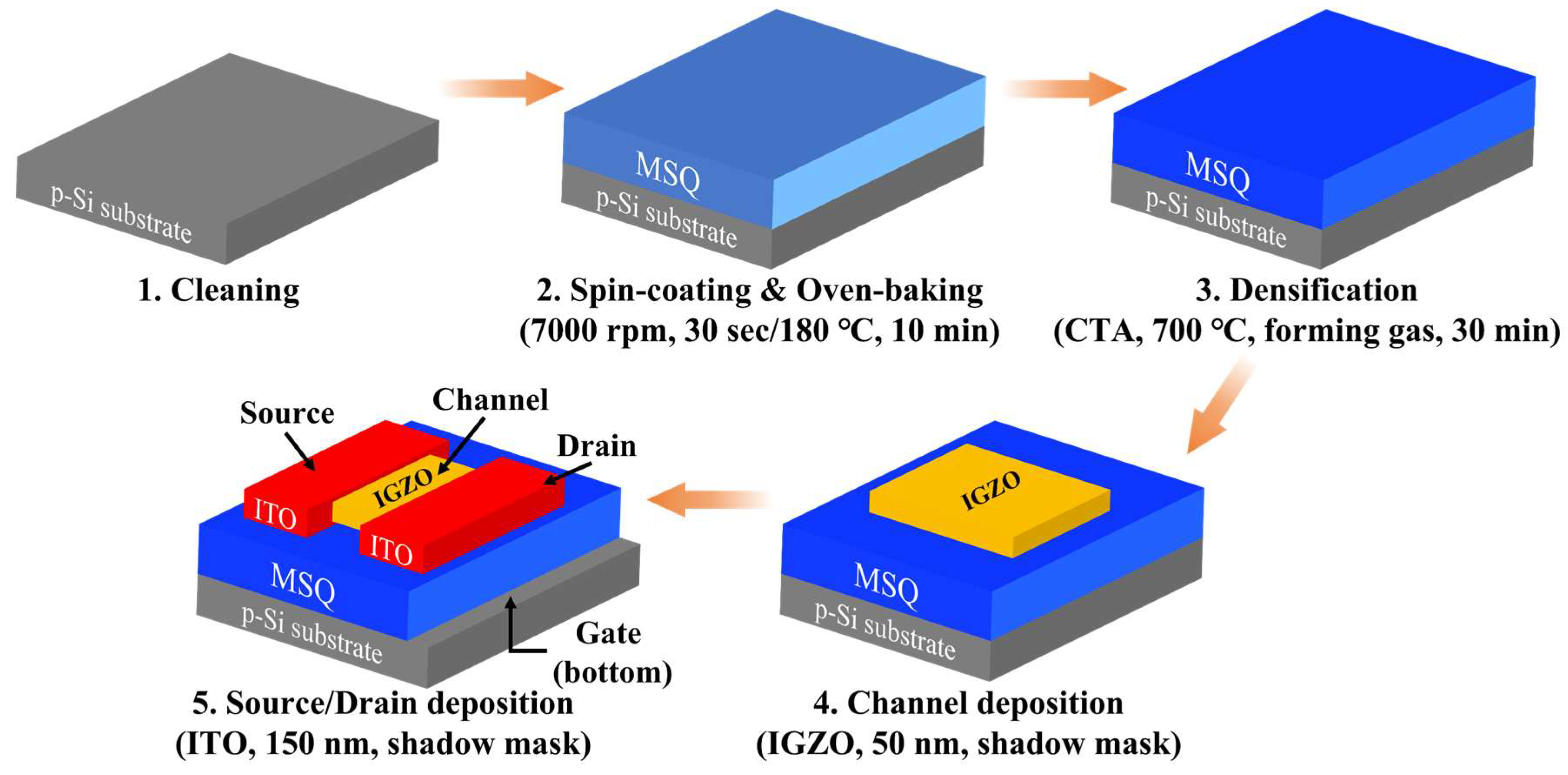
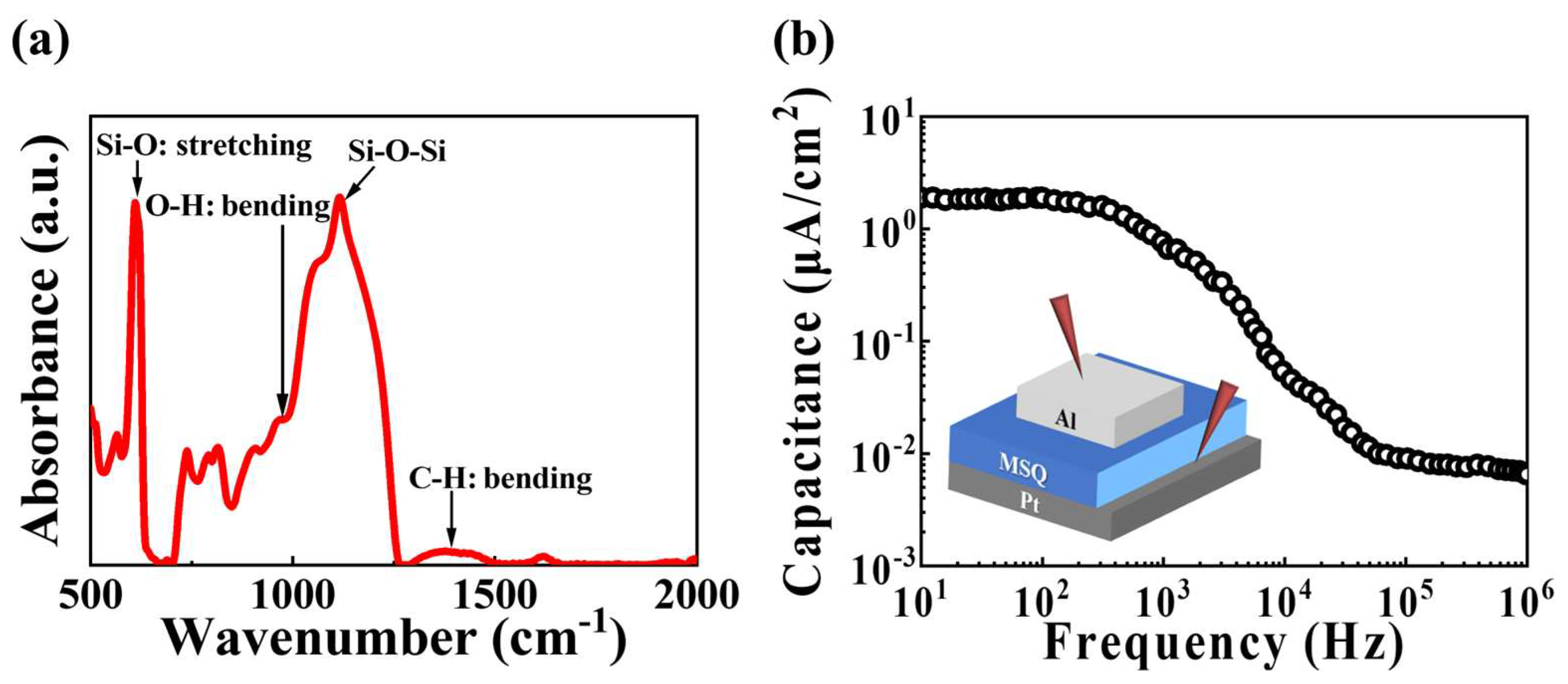

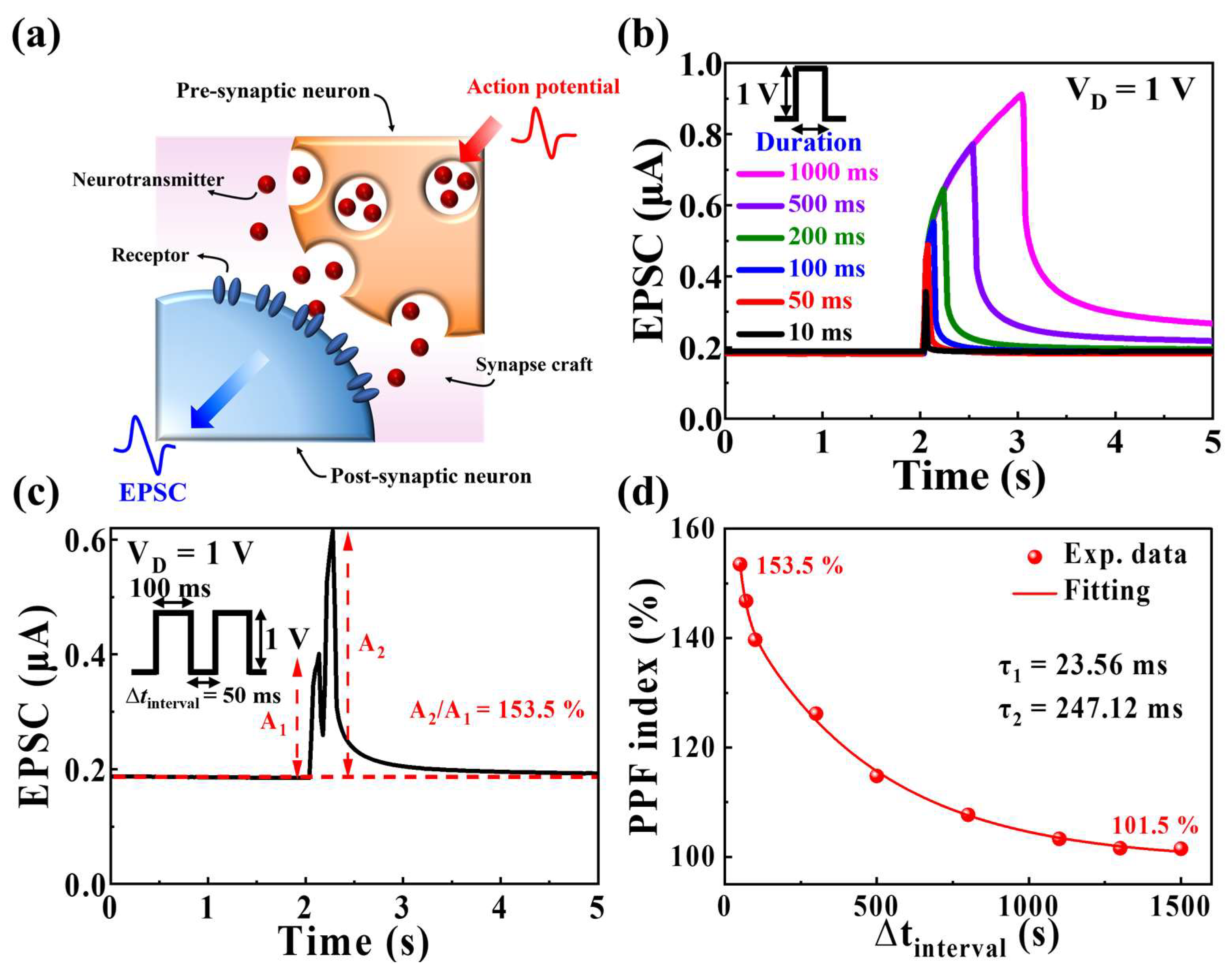
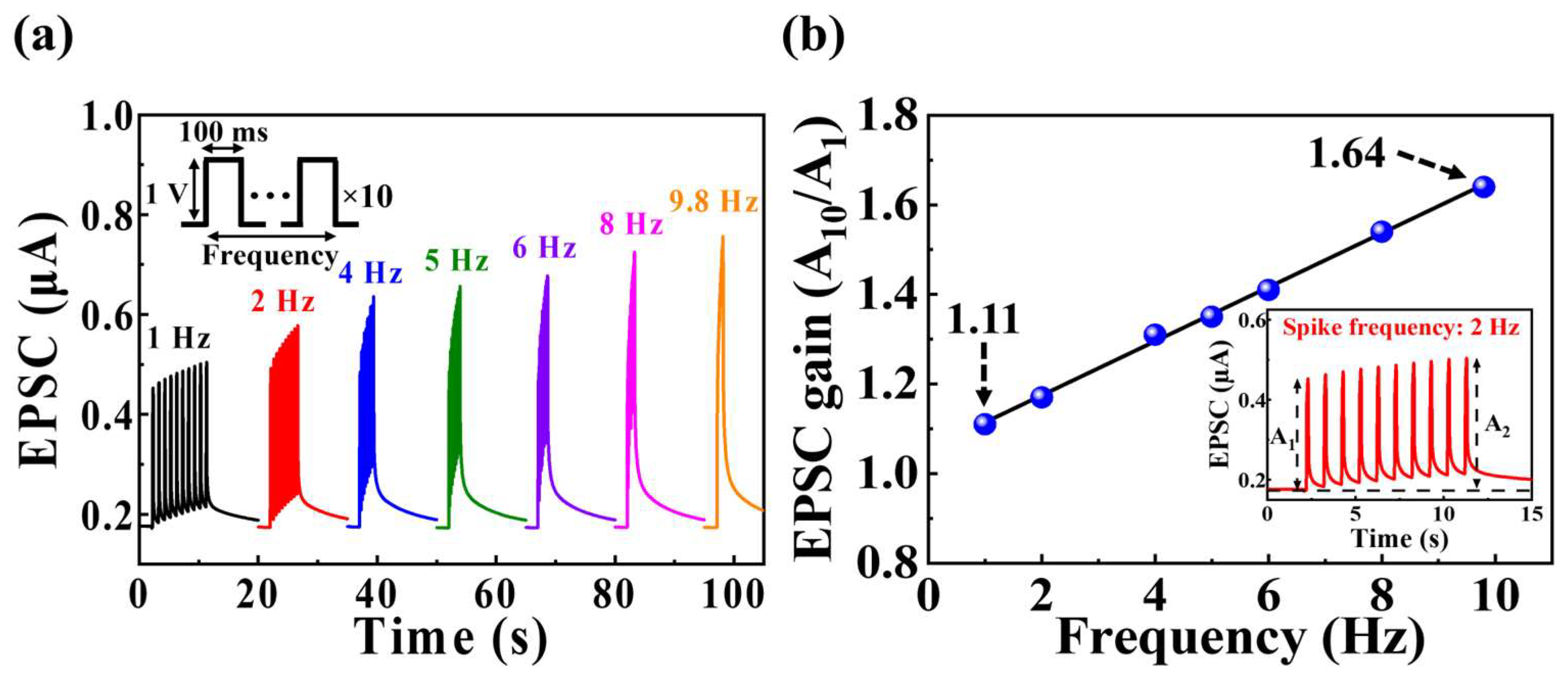
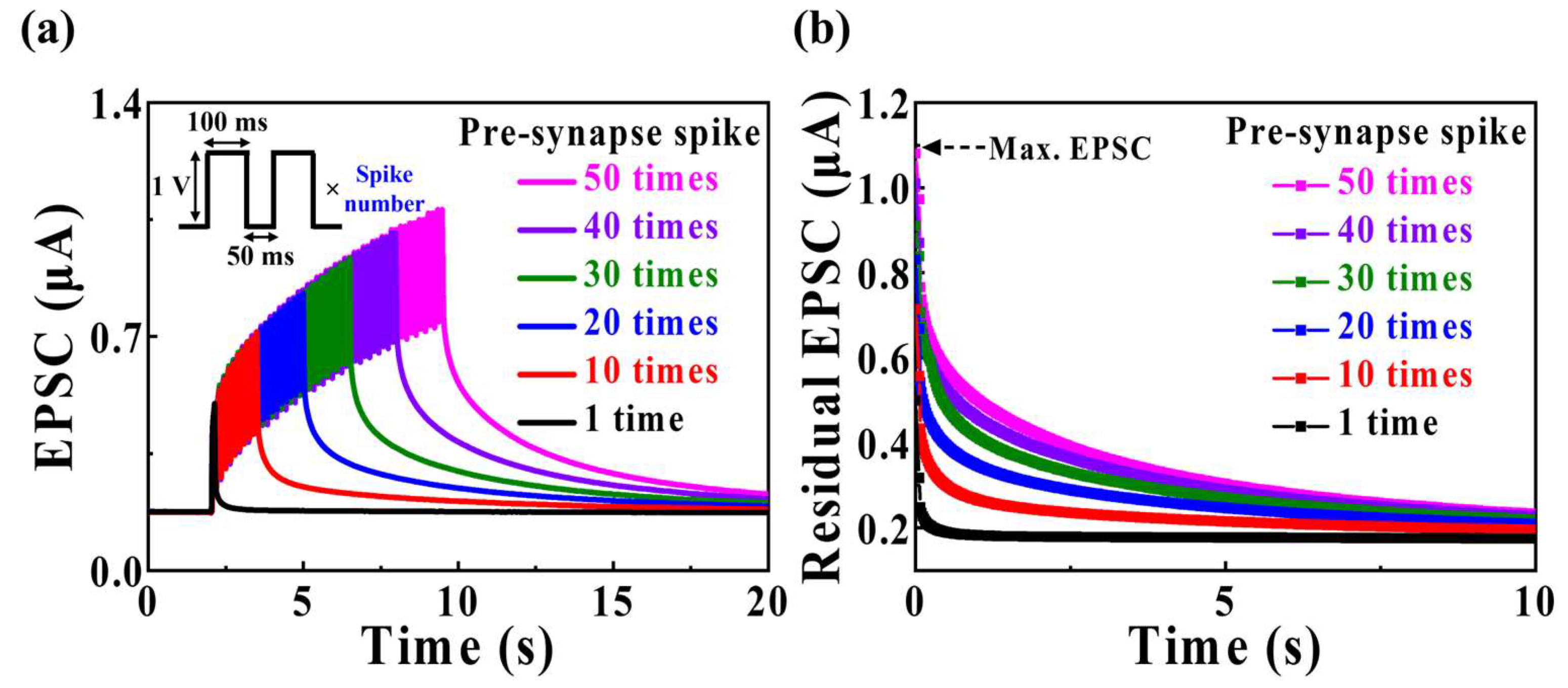
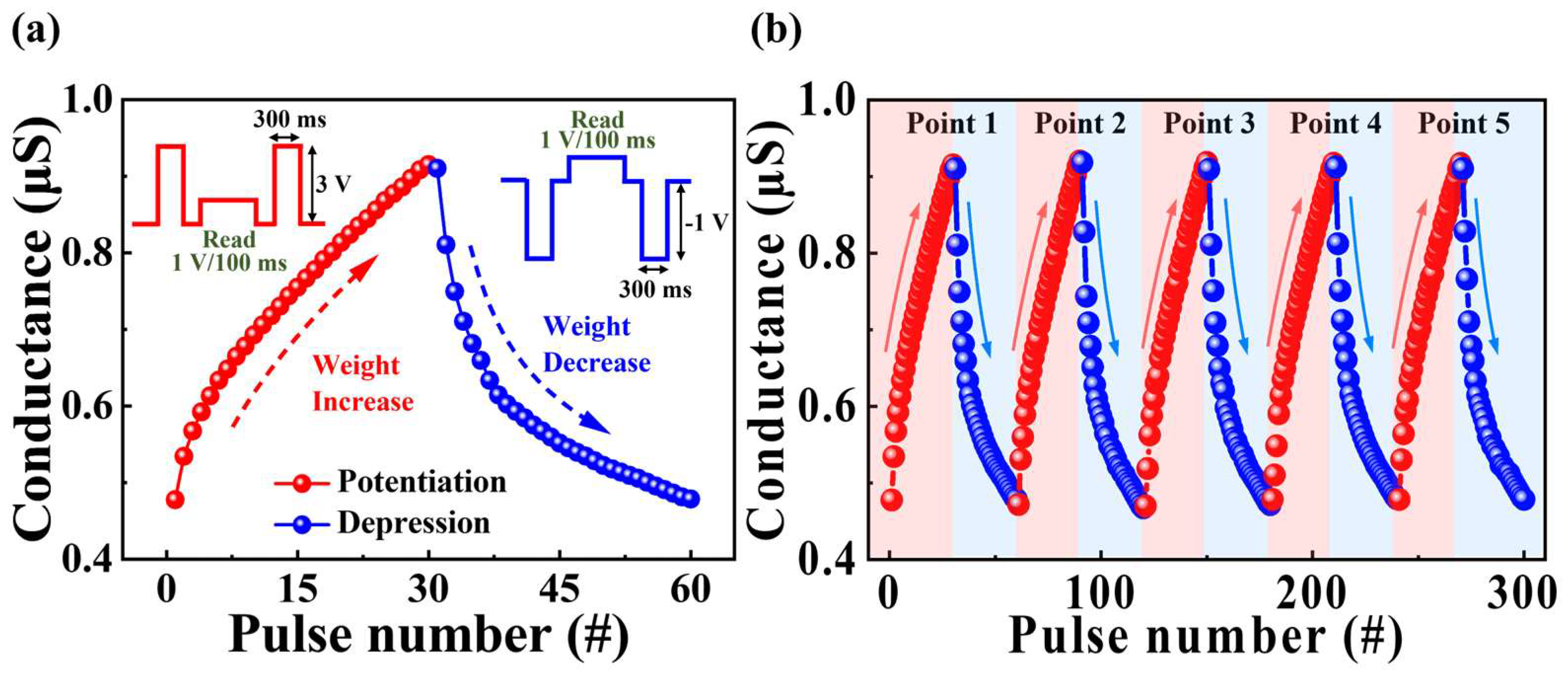
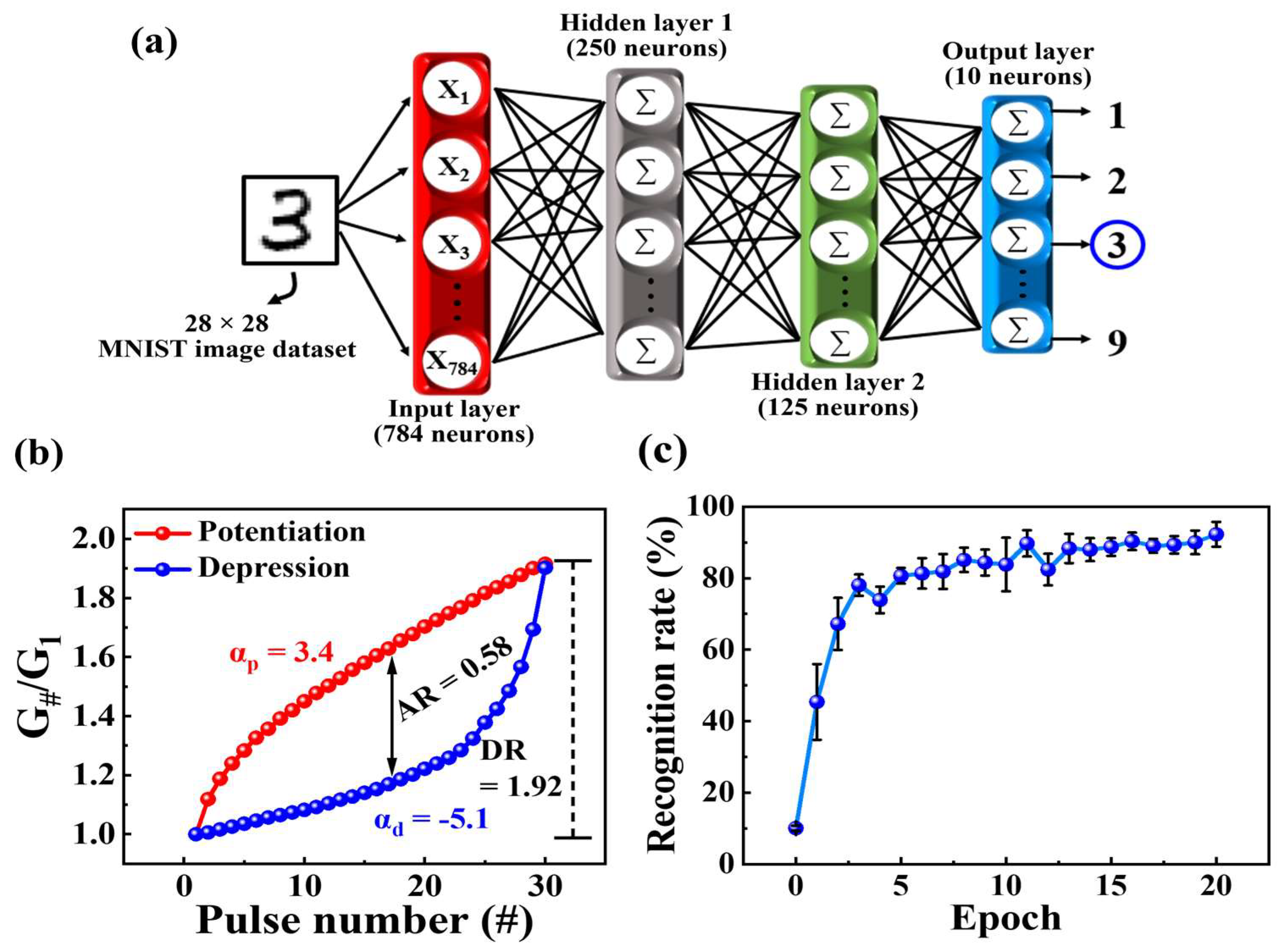
Disclaimer/Publisher’s Note: The statements, opinions and data contained in all publications are solely those of the individual author(s) and contributor(s) and not of MDPI and/or the editor(s). MDPI and/or the editor(s) disclaim responsibility for any injury to people or property resulting from any ideas, methods, instructions or products referred to in the content. |
© 2024 by the authors. Licensee MDPI, Basel, Switzerland. This article is an open access article distributed under the terms and conditions of the Creative Commons Attribution (CC BY) license (https://creativecommons.org/licenses/by/4.0/).
Share and Cite
Hwang, T.-G.; Park, H.; Cho, W.-J. Organic–Inorganic Hybrid Synaptic Transistors: Methyl-Silsesquioxanes-Based Electric Double Layer for Enhanced Synaptic Functionality and CMOS Compatibility. Biomimetics 2024, 9, 157. https://doi.org/10.3390/biomimetics9030157
Hwang T-G, Park H, Cho W-J. Organic–Inorganic Hybrid Synaptic Transistors: Methyl-Silsesquioxanes-Based Electric Double Layer for Enhanced Synaptic Functionality and CMOS Compatibility. Biomimetics. 2024; 9(3):157. https://doi.org/10.3390/biomimetics9030157
Chicago/Turabian StyleHwang, Tae-Gyu, Hamin Park, and Won-Ju Cho. 2024. "Organic–Inorganic Hybrid Synaptic Transistors: Methyl-Silsesquioxanes-Based Electric Double Layer for Enhanced Synaptic Functionality and CMOS Compatibility" Biomimetics 9, no. 3: 157. https://doi.org/10.3390/biomimetics9030157
APA StyleHwang, T.-G., Park, H., & Cho, W.-J. (2024). Organic–Inorganic Hybrid Synaptic Transistors: Methyl-Silsesquioxanes-Based Electric Double Layer for Enhanced Synaptic Functionality and CMOS Compatibility. Biomimetics, 9(3), 157. https://doi.org/10.3390/biomimetics9030157





